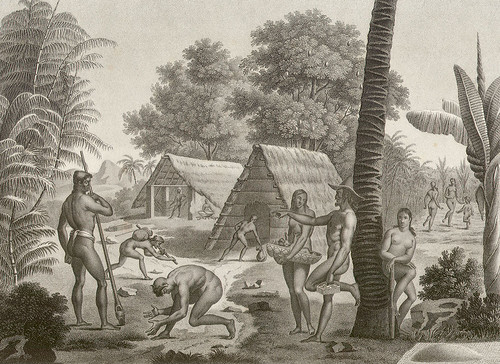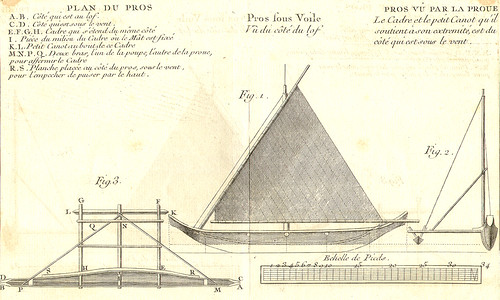Offered ethnographical and historical data
Early European observations of the CHamorus people represent a significant source of ethnographical and historical information. Many comments made by visitors to the Marianas focus on visible realities such as nudity, body ornaments, structures and watercraft. There are also more detailed observations coming from sailors such as Gonzalo de Vigo, who lived for more than three years in the archipelago after jumping a ship that was part of the Magellan expedition in 1521:
These well-formed men, who went naked… even the women showed their private parts. Villages waged war on each other… there was a king in each village, and the people worshipped their dead. Having interred a chief, and seen that his corpse had decomposed, they would remove the bones and venerate them.
Other Spaniards who had long stays in the islands also left interesting references, such as the missionary, Fray Juan Pobre de Zamora in 1602, and others at different times. Pobre’s writings constitute one of the most significant documentary sources because of his description of social stratification and cultural realities that, at that time, had not been massively altered by the presence of the few foreigners who stayed on the islands.
Today, there is an undetermined number of narratives and diaries written during the times of the Manila Galleons held in historical archives in Spain, but the contents of these documents remain widely unknown.
The first written observations of CHamorus were conditioned to meet the material needs, ideological priorities and specific conditions of the different European explorers who arrived at the Marianas. These initial observations concerning ancient CHamorus were not made from a scientific viewpoint (ethnographic history, as a discipline, would not appear until the end of the 18th century), hence the texts must be put into context.
In general terms, ancient CHamorus were described with the following characteristics:
Robust, well built, good swimmers
According to Esteban Rodríguez, pilot of the Legazpi voyage in 1565, CHamorus were well built, brawny, tall, and had great strength. They were born with a skin color almost white, becoming darker as they grew older. The women had a somewhat lighter skin complexion, compared to Filipinos, with black hair flowing down to their waists.
They were skilled swimmers, and while in the water, they were said to be able to catch fish with their bare hands. Men and women were naked, but women sometimes wore a cord around their waists to which they would hang some grass or leaves. Men would sometimes wear a waistband but were generally naked.
Houses built on stone pillars
The villages the Europeans saw were distributed along beaches and coves, near rivers or fresh water springs and sources of food. The stone pillars upon which the houses stood where called latte, and one of these buildings, in the shape of a cross, was particularly large:
Their houses are the cleanest that I have yet found among the indios; built of coconut and (palo) maria wood with roofs of coconut leaves curiously woven. They have four rooms, with doors or curtains of the same matting. One serves a sleeping room, another for storing goods, one has a kitchen, and the fourth is large enough in which to build and store boats.
Outrigger canoes or proas
The CHamoru proas amazed Spanish and other Europeans. Their fascination came from the the way the canoes were built and the CHamoru’s capacity to maneuver them, as well as their speed.
Their canoes surely have the lightest movement of any in the whole world… They are extremely narrow and elongated, and their prow is just like their stern, which may serve as the prow in every way. The craft carries a counterweight on one side, so that it will not capsize. This is a thick, but light spar, lashed alongside the canoe with crossbars. It will skim the water as it goes along. This counterbalance is carried on the windward side, so that one side always serves as windward and the other as leeward. As for their sails, they are made of lateen cut into a triangular shape… The sails are of palm leaves, so delicately made that they seem almost silken.
These people’s canoes are well constructed, and they sail quite close to the wind. They are fitted only with one outrigger, which enables them to keep their balance while sailing. It is extended further from the canoe hull, or brought in closer to it, depending on the strength of the wind. With these craft, the natives are able to venture as far as two or three miles out from shore, even in rough seas, for if they capsize, these canoes are easily righted and bailed out.
For further reading
Barratt, Glynn. The Chamorros of the Mariana Islands: The Early European Records, 1521-1721. Saipan: Commonwealth of the Northern Mariana Islands Division of Historic Preservation, 2004.
Driver, Marjorie G. The Account of Fray Juan Pobre’s Residence in the Marianas, 1602. MARC Miscellaneous Series No. 8. Mangilao: Micronesian Area Research Center, University of Guam, 1993.
García, Francisco. The Life and Martyrdom of Diego Luis de San Vitores, S.J . Translated by Margaret M. Higgins, Felicia Plaza, and Juan M.H. Ledesma. Edited by James A. McDonough. MARC Monograph Series 3. Mangilao: Micronesian Area Research Center, University of Guam, 2004.




